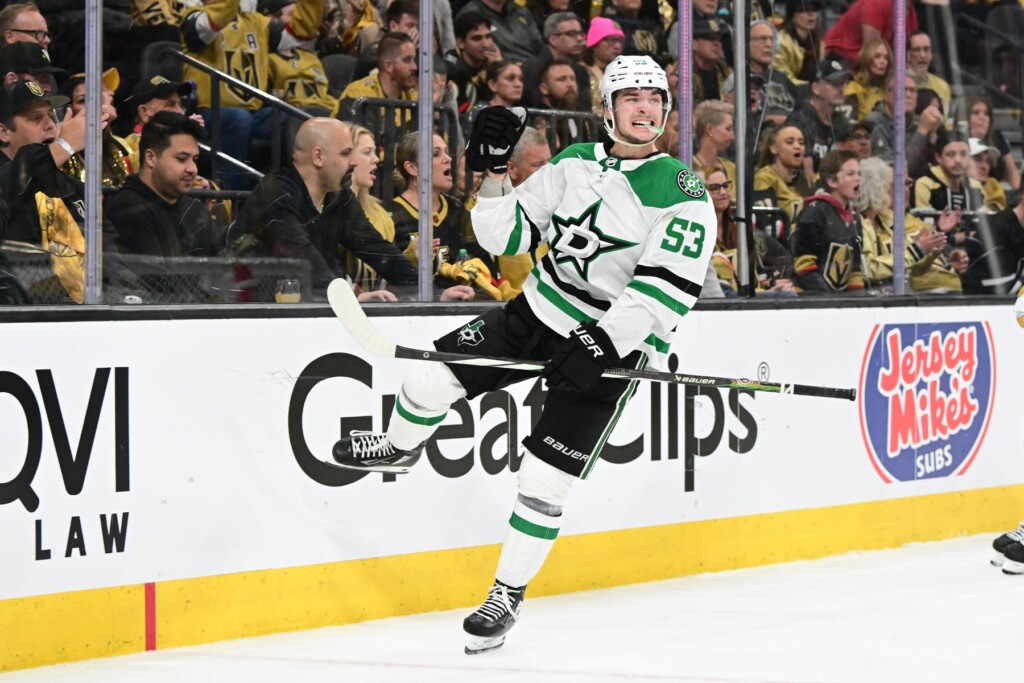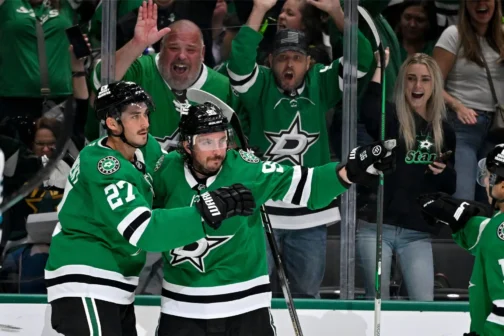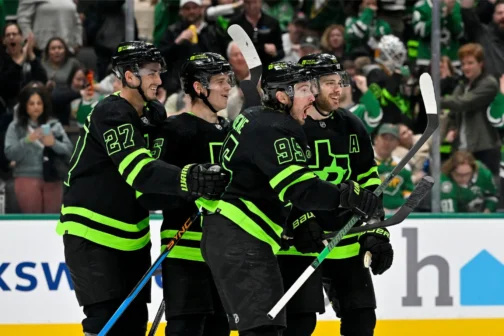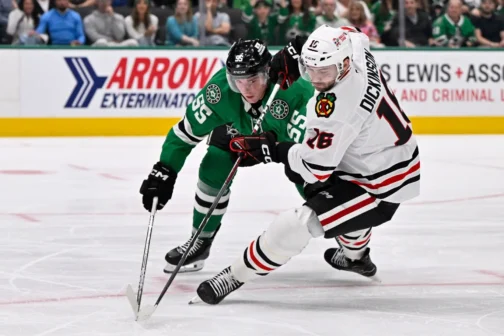Last year, the Stars were thrilled to have Wyatt Johnston break camp as a rookie 19-year-old fresh out of the OHL, a league in which players typically range from 16 to 20 years old. It was a neat story for Johnston to be playing on Jamie Benn’s wing and living in Joe Pavelski’s house, never even sniffing the AHL on his way to NHL-regular status.
At least, it started as a neat story. But as the season went on, Johnston’s progression became less of a novelty and more of a necessity for a team with its eyes on playoff glory. His big moment came in a Game 7 win against Seattle, when Johnston scored a goal we’ve all watched countless times by now.
It was great to see a fresh-faced kid making a name for himself. It reminded Stars fans of players including James Neal, or even a young Benn: upstart forwards who burst onto the scene and immediately showed they could hang with their veteran peers, even in the intensity of a deep playoff run. Johnston became part of a solid third line with Benn and Evgenii Dadonov, looking like one of those depth forward lines who makes the odd contribution in a playoff game, but nothing more.
This year, we know better. Johnston is no longer simply a character in a great story, but the title of the anthology. The just-turned-21-year-old has become the Stars’ top forward and centerman, and an elite one at that. He has been one of the primary reasons Dallas is on the cusp of another Western Conference final.
But his dominance as a player was there to be seen even before his two-goal performance against Colorado on Monday night, which included a host of beautiful highlights. Johnston was fearless, dominant, and efficient, scoring goals and setting up an empty-netter while effortlessly controlling the ice during his shifts.
Those shifts are coming more quickly than ever now. Earning a coach’s trust is a tough thing, especially for a young player in the playoffs. (Just ask Nils Lundkvist how hard it can be to get ice time in high-stakes games.) But Johnston has earned every bit of trust there is to earn from Peter DeBoer and his coaching staff, as evidenced by the fact that Johnston is the only Stars forward to average more than 20 minutes per game in the playoffs. That’s a glowing testimonial from a coach if I’ve ever seen one, and Johnston has validated it. It’s something that Stars fans might be tempted to take for granted, just because of how consistent Johnston has been. But what he has done already in his short career has been anything but commonplace.
We should take a moment to acknowledge that, yes, there have been other flash-in-the-pan Stars forwards who got folks excited for a bit until they came back down to earth. We remember the shooting-percentage bender that Alex Chiasson went on after his call-up at the end of the lockout-shortened 2013 season, when he scored six goals in seven games. Neal seemed like exactly what Dallas needed to complement Benn, bringing size and a wicked shot to the group right before being traded for a veteran defenseman. Then there was the NHL-debut hat trick by Fabian Brunnström, whom you don’t remember, and for good reason. Johnston didn’t immediately pop like any of those players, because he wasn’t any of those players. Rather than burning out or fading away, he has been glowing more brightly the tougher things have gotten, until he finally began to light up the playoffs.
Of course, Johnston isn’t the only great young forward on his team. Jason Robertson, now 24, most recently crashed the NHL party with high expectations from his junior scoring numbers, but aside from a brief COVID-year cameo, he didn’t arrive as a full-time NHLer until his age-21 season—and as a winger who isn’t asked to kill penalties. Besides, Robertson has also had to learn the hard lessons that playoff hockey brings, as his first two years necessitated plenty of adjustments to the postseason before he finally found solid ground against Vegas last year. Robertson is now a bona fide star, but he’s a winger with great defensive aptitude and remarkable scoring instincts, not all-around utility. While that’s not necessarily less than what Johnston is doing, it is different by virtue of the limitations. Johnston, conversely, has been a force on the penalty kill, scoring three shorthanded goals this season to accompany his most recent one against Colorado on Monday night. He has been used everywhere, any time, in any situation. And his performance still seems like it came out of nowhere.
Even Tyler Seguin already had a lot to his offensive reputation before Jim Nill acquired him on that Independence Day 11 years ago, so it was less surprising to see Seguin immediately turn into a pivotal part of the attack. But Seguin also needed time to refine his game, and it wouldn’t be until the return of Ken Hitchcock in 2017 that Seguin became viewed as a complete center who could play in any situation, including on the penalty kill. Seguin also didn’t have a meaningful playoff run until he was 27, under Jim Montgomery, whereas Johnston is on the cusp of his sixth playoff series in two years in which his coach almost can’t play him enough. If you watched the game on Monday, you know why:
Even Benn was a force on the wing in his rookie season, scoring the same 41 points as a 20-year-old that Johnston did at age 19 last year. But Benn also played on a team that never threatened to make the playoffs in his first four seasons. His dynamite power-forward displays were very different stylistically from Johnston, who has played on the top line and the third line, on the penalty kill and the power play, with an empty net behind him or in front of him. While Benn was knocking over players and punching them out early in his career, Johnston has made his mark in the league by staying in dangerous areas and being strong on his skates, constantly finding the right route, the right play, the right shot. You’d say he was greater than the sum of his parts, except each part of his game is worth admiring, too.
Hockey IQ is a nebulous stat, but it’s often used to describe players who make good plays despite lacking any obvious physical gift over their counterparts. Johnston, at 6-foot-1 and 185 pounds, does not strike anyone as a behemoth of an NHL center. But despite how tough it’s supposed to be to get to the net in the playoffs, he leads all NHL skaters in shots this postseason. It’s not just the shots, though. It’s the fact that they’re going in, and whom he’s doing it against. Vegas was a heavy team defending a championship, but it didn’t matter to Johnston, who became one of only eight players in NHL history to score 10 playoff goals before turning 21.
Other circumstances could have slowed his progress, too. Johnston only played on the second power play this year, getting far fewer offensive zone starts or consistent linemates. Nonetheless, he put up 65 points in 82 games while leading the team in goal-scoring. That’s about as far from a sophomore slump as you can get.
But the bigger change came in the playoffs, where Johnston has raised his game to an even higher level. He’s scoring a point per game, and he’s leading the Stars with seven goals, many of them at critical times. And again, he’s doing this all as a centerman, matching up against the toughest players the opponent can throw at him. But if Nathan MacKinnon and Mark Stone haven’t fazed him, you begin to wonder if anyone will.
And on Monday, Johnston added the latest bit of brilliance, when he puck-jacked Cale Makar, who has won a Norris Trophy for the best defenseman in the NHL and been nominated for it four years running. In a pivotal playoff game, Johnston casually made that player look like an inexperienced rookie:
Wyatt Johnston against Cale Makar was BEAUTIFUL. #TexasHockey pic.twitter.com/KbiXKbPgB8
— Nathan "Grav" Murdock (@NathanGraviteh) May 14, 2024
Players this young simply aren’t supposed to be doing this unless their first name is Connor, Wayne, or Mario. Johnston was a 23rd pick in 2021, not some superstar-in-waiting who teams tanked a season for in order to have a chance to draft him. But try telling that to the Colorado Avalanche, because from where they’re standing right now, Johnston is as dominant as any player they could have faced in the postseason, regardless of the first name.
For Johnston and the Stars, these playoffs are coming at the perfect time, combining an ideal mix of talented youth who can contribute with reliable veterans who still have most of their fastball left. And with Roope Hintz questionable to return in the series, Johnston’s contributions will be more important than ever. Not only has he shown he can endure tough playoff hockey without disappearing, he’s also leading the way.
The reality is that Johnston isn’t the next Benn, Seguin, or Robertson. If the playoffs are the proving ground for elite players, then the fact of the matter is that Johnston’s nearest comparison in franchise history has a statue outside American Airlines Center.
At the end of the game on Monday, Johnston was skating toward an empty net with a chance for a playoff hat trick on his stick. But then he made the smarter play, feeding Sam Steel for the better shot, and the goal that sealed the game. Because if his coach can trust Johnston to do what’s best, the least he can do is return the favor.
Author






